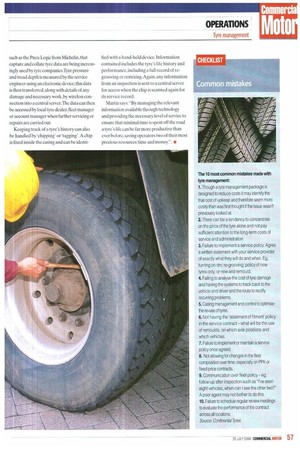Common mistakes
Page 59

If you've noticed an error in this article please click here to report it so we can fix it.
The 10 most common mistakes made with tyre management: 1. Though a tyre management package is designed to reduce costs it may identify the true cost of upkeep and therefore seem more costly than was first thought if the issue wasn't previously looked at.
2. There can be a tendency to concentrate on the price of the tyre alone and not pay sufficient attention to the long-term costs of service and administration 3. Failure to implement a service policy. Agree a written statement with your service provider of exactly what they will do and when. Eg, turning on rim; re-grooving; policy of new tyres only; or new and remould.
4. Failing to analyse the cost of tyre damage and having the systems to track back to the vehicle and driver and the route to rectify recurring problems.
5. Casing management and control to optimise the re-use of tyres.
6. Not having the 'statement of fitment' policy in the service contract-what will be the use of remoulds, on which axle positions and which vehicles.
7. Failure to implement or maintain a service policy once agreed.
8. Not allowing for changes in the fleet composition overtime; especially on PPK or fixed price contracts.
9. Communication over fleet policy eg, follow-up after inspection such as "I've seen eight vehicles, when can I see the other two?" A poor agent may not bother to do this.
10. Failure to schedule regular review meetings to evaluate the performance of the contract across all locations.
Source: Continental Tyres






























































































































































































